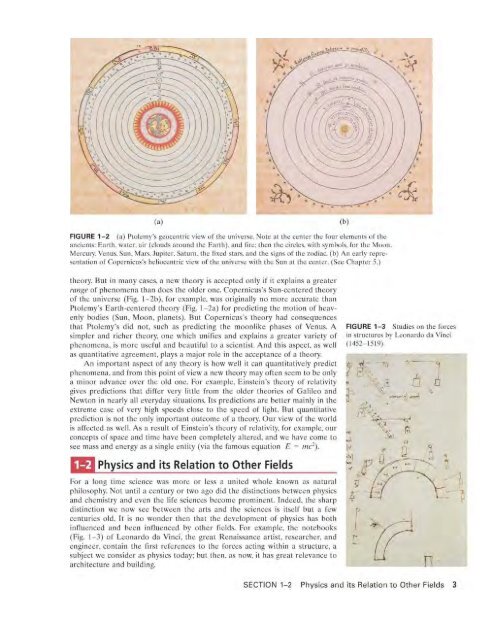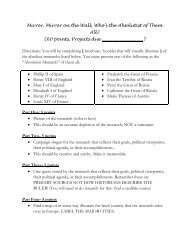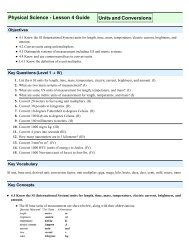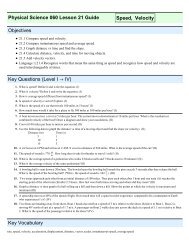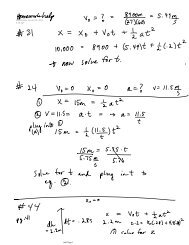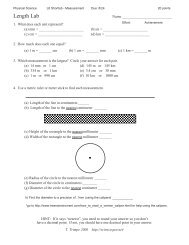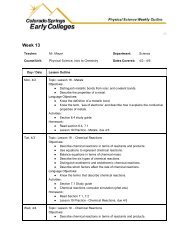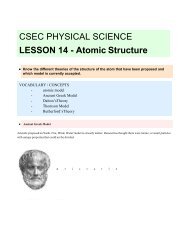arc considered optional. They can be o
arc considered optional. They can be o
arc considered optional. They can be o
- No tags were found...
Create successful ePaper yourself
Turn your PDF publications into a flip-book with our unique Google optimized e-Paper software.
", , ,•,•(a)FIGURE 1- 2 (aJ 1' lOlcmy"~ geocemric \";cwof the unh'~""', NOle .llhe ccnl~f the fou , dements of Ih<strong>can</strong>ci~nlS: Earth. "-ateL air (douds around the Earth), and fire: then the cirdes. "'jth symbols. for lh~ Moon.Mercur)'. Venus. Sun. M;>!"S- Jupiter. Saturn. Ihe fi'Crl stars. and Ihe signs of InC 7.odia,. (h) An carl)' rcpresent.lionof Copernicus's heliocentric "ie'" of the universe with the Sun al the center. (Sec Chapler 5.)("'lheory. BUI in many cases. a new thwry is accepted only if it explains a greaterrtlnXe of phenomena lhan docs the older one. Copernicus's Sun-centered th~ oryof Ihe universe (Fig. 1- 2b). for example. was originally no more accurate thanl'tolcmy"s Earth-ccntcrcd theory (Fig. 1- 2a) ror predicting the motion of Ileav.en ly bodies (Sun. Moon. planets). But Copernicus's theory had oonsequen(Xsthat Ptolemy's did not. such as predicting th e moonlike pllases of Venus. Asimpler and richer th eory. one which unifies and explains a greater variety ofphenomena. is more useful and bcall1iful 10 a scientist. And this aspect. as wellas quantitmivc agreemeil1. plays a major role in the acceptance of a theory,An important aspect of any tlleory is how well it <strong>can</strong> quantitat ively predictph~nomena. and from this point of view a new theory may often seem to <strong>be</strong> only" minor adv;lIlce over the old one. For n"mple. Eill8tein-s theory of rd"t;vitygi"es predictions that differ wry li(tle from the older lhcorits of Galilco .1ndNewton ;11 Ilcarly all everyday situ"tions. I\s predictions <strong>arc</strong> <strong>be</strong>tter m"inly in thee ~tr em e case of \'C ry high spceds clo~e to Ihc speed of light. Rut qU;lIllitativeprediction i, not the oll ly importallt outcome of a theory_ 0 ur ,-iew of the worldis "frected :18 well. A:; a result of Ein~ tein'~ theory of rel"I;"ity. for example, Ollrconcepls of 8pace and time have <strong>be</strong>ell completely :.ttered, :md we h:I\'c come 10see m;lS:; and energy:l>:> sillgle tlltit)' (via the f"mous equ'llion E = m,')_FIGURE 1-3 SlUdi~s()n {he f"rc~s,n ~ ('UClU'CS b)" u:on",do da Vinci(U52-1519),and its Relation to Other FieldsFor a long time science was more or less a united whole known as naturalphilosophy. NOl until a century or IWO ago did Ihe distinctions <strong>be</strong>tween physicsand chemistry and even the life sciences <strong>be</strong>eome prominent. Indeed. the sharpdistinction we now sec <strong>be</strong>tween the arts and the sciences is itsclf but a fewcenturies old. It is no wonder th en thm the dewlopment of physics has bothinfluenced and <strong>be</strong>en influenced by olher fields. For example. the notebooks(f ig. 1- 3) of Leonardo da Vinci. the great Renaissance artist. rcseareha. andengineer. contain the tirst references to the forces acting within a structu r ~. asubject we consider as physics today: but then. ns no\\'. i1 has grcal relevance to<strong>arc</strong>hitectufe a nd building.pIncr?_ 1",-l,SECTION 1- 2 Physics and its Relation to Other Fields 3


